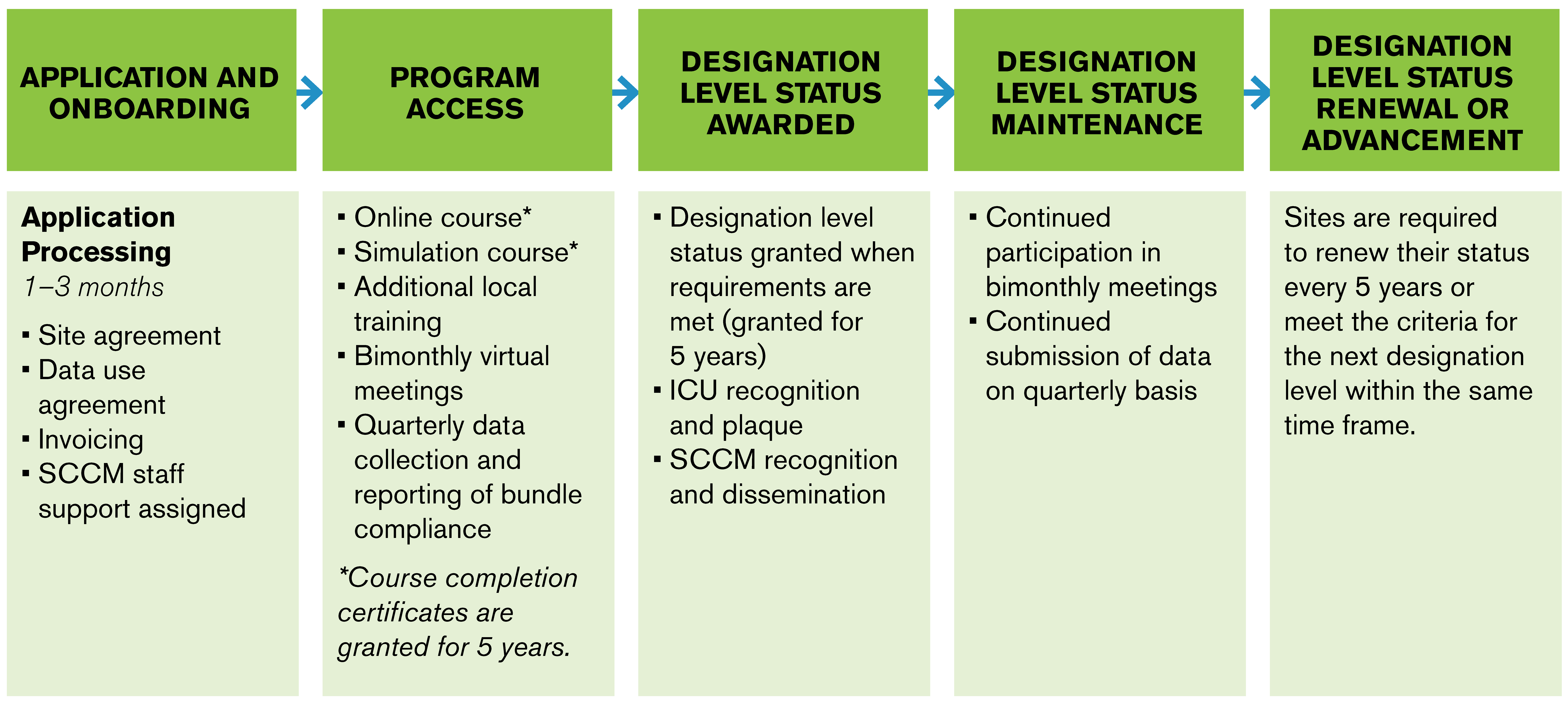The Society of Critical Care Medicine (SCCM) launched the ICU Centers of Excellence Program which seeks to encourage quality bedside intensive care unit (ICU) practice and outcomes awareness, recognizing ICUs that reach high levels of proficiency with a gold, silver, or bronze designation.
The Society of Critical Care Medicine (SCCM) launched the ICU Centers of Excellence Program at its 2025 Critical Care Congress. This new program seeks to encourage quality bedside intensive care unit (ICU) practice and outcomes awareness, recognizing ICUs that reach high levels of proficiency with a gold, silver, or bronze designation (
Figure 1). Similar quality designation programs exist in other fields of medicine, awarded by leading organizations such as the American Heart Association, American Stroke Association, and American College of Surgeons Committee on Trauma.
The principal goal of SCCM’s ICU Centers of Excellence program is to assist ICUs in learning about and following validated clinical practice guidelines and approaches that optimize bedside ICU care. Additionally, the program seeks to help individual ICUs gather their own patient outcome data and closely follow their progress and improvements in patient care over time and, finally, to recognize these important efforts publicly.
The program facilitates education and implementation of existing expert quality improvement programs and supports the collection of data from independent ICUs. Collectively, these data will generate a dashboard of information on ICU quality metrics that will ultimately serve for benchmarking across similar ICUs. The ICU Centers of Excellence program currently uses quality metrics from the ICU Liberation Bundle (A-F) as its first quality improvement module. In the future, additional modules, such as sepsis, will be added.
The ICU Liberation Bundle is a comprehensive, published, and validated approach that has been shown to reduce ICU length of stay for critically ill patients, which was developed as part of the ICU Liberation Collaborative Project. It is grounded in evidence and recommendations from the guidelines on prevention and management of pain, agitation/sedation, delirium, immobility, and sleep disruption (PADIS).
1,2 The bundle has six elements: A) assess, prevent, and manage pain; B) both spontaneous awakening trials and spontaneous breathing trials; C) choice of analgesia and sedation; D) assess, prevent, and manage delirium; E) early mobility and exercise; F) family engagement and empowerment.
The objectives of the ICU Liberation Campaign are to transform ICU culture and practice by improving bedside team dynamics while increasing clinicians’ care quality and work satisfaction, improving short- and long-term ICU patient outcomes, and achieving earlier discharge from the ICU.
3-5 The ICU Liberation Bundle further enhances patient care by reducing readmission rates, decreasing length of stay, and generating cost savings associated with complications and preventable harm.
6, 7
The Society’s quality and patient safety business line leaders, Marie R. Baldisseri, MD, MPH, FCCM; José L. Díaz-Gómez, MD, MAS, FASE, FCCM; and Neha S. Dangayach, MD, FCCP, FNCS, FAAN, FCCM, worked closely with SCCM Director of Research and Quality, Vishakha Kumar, MD, MBA, and the research and quality team to develop the Centers of Excellence program, building on the strong foundation of SCCM’s quality improvement initiatives such as the ICU Liberation Campaign.
An ICU participating in the program receives monthly education, implementation tools, and training for their multiprofessional teams. By providing education through literature, tabletop simulations, and direct consultation, the ICU Centers of Excellence Program assists ICUs in implementing a validated quality program for their bedside practitioners with the goals of increasing both patient- and family-centered care as well as clinician satisfaction.
To join the ICU Centers of Excellence program, an ICU must submit an application and assemble a team to manage the program locally. Core ICU leaders and team bedside champions from each ICU profession must complete online courses, with certain team members also completing a simulation course. These baseline educational and engagement requirements are then followed by monthly virtual meetings with SCCM quality and safety staff and quality experts. Each ICU’s designated champions must attend to discuss ongoing patient outcomes and compliance challenges, share success stories, and receive guidance on the modules by subject matter experts.
Participating ICUs are eligible to be designated in a tier of bronze, silver, or gold, all of which can be attained by greater fulfillment of bundle metrics. All three levels require educational engagement and the quarterly submission of data on bundle metrics. Bronze-level recognition requires at least 80% compliance in eligible patients over three consecutive months for at least two bundle elements. Silver-level designation requires at least 80% compliance in eligible patients over three consecutive months for at least four bundle elements. Gold-level designation requires at least 80% compliance in eligible patients over three consecutive months for at least six bundle elements. As other quality performance modules are added in the future, recognition designation tiers will become more complex. Anonymous compliance results will be shared with all ICUs, allowing each ICU to compare its results with others in the same context.
SCCM will recognize ICUs with a plaque to be displayed in the site’s ICU in view of staff and hospital administrators, as well as patients and families. Additionally, the ICU’s accomplishments will be posted on the SCCM website to be linked by the ICU’s hospital administration website. Finally, SCCM will formally acknowledge top-tier ICUs at its annual Critical Care Congress.
Participation by multiple ICUs in a hospital or hospital system will help harmonize care across units, bringing them together with similar standards, promoting shared best practices and high reliability consistent with national and international benchmarks. SCCM will charge nominal fees for enrollment and maintenance of the program, with additional costs incurred for online courses and simulation training.
I would like to invite all SCCM members and ICU leaders who are interested in joining SCCM’s ICU Centers of Excellence Program to view the details online at
sccm.org/excellence and/or connect with me (
president@sccm.org) or SCCM staff with any questions or comments.

